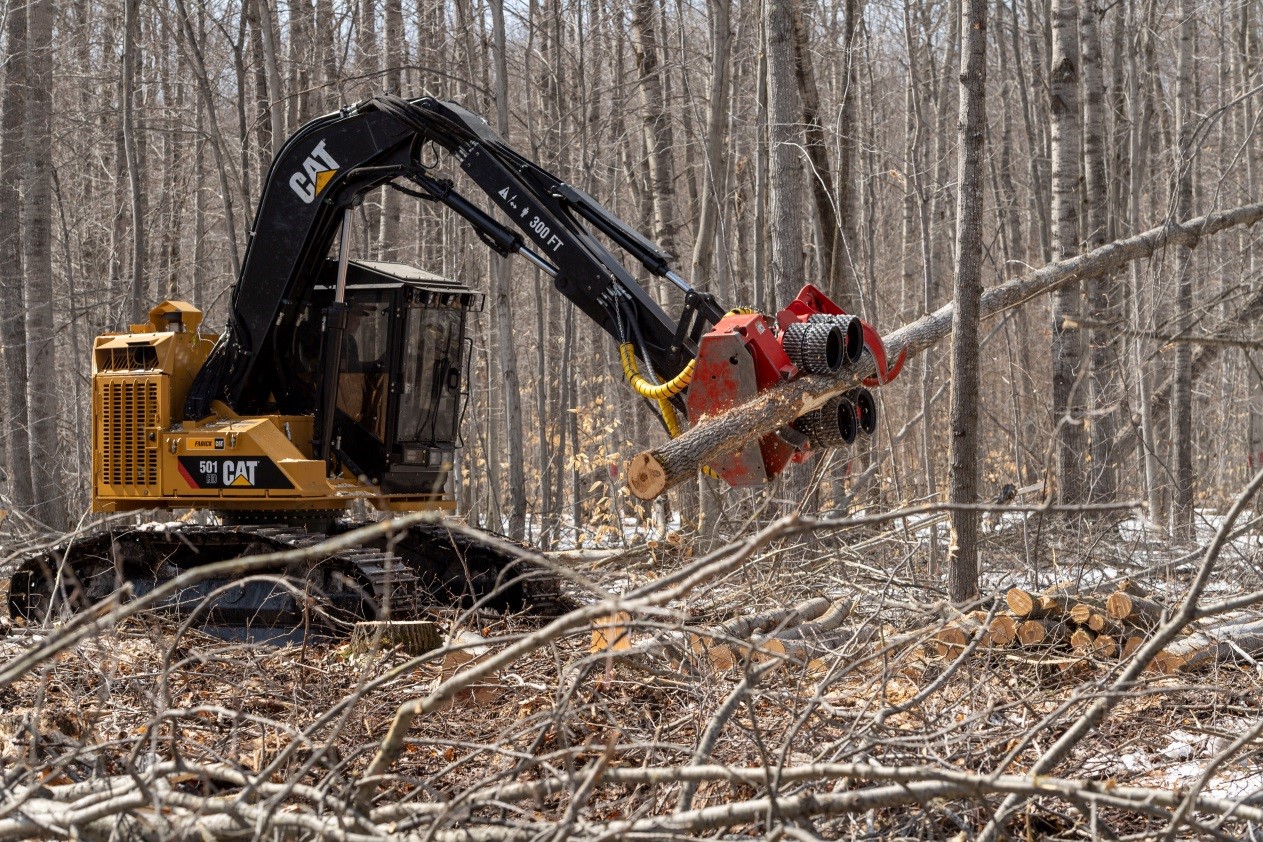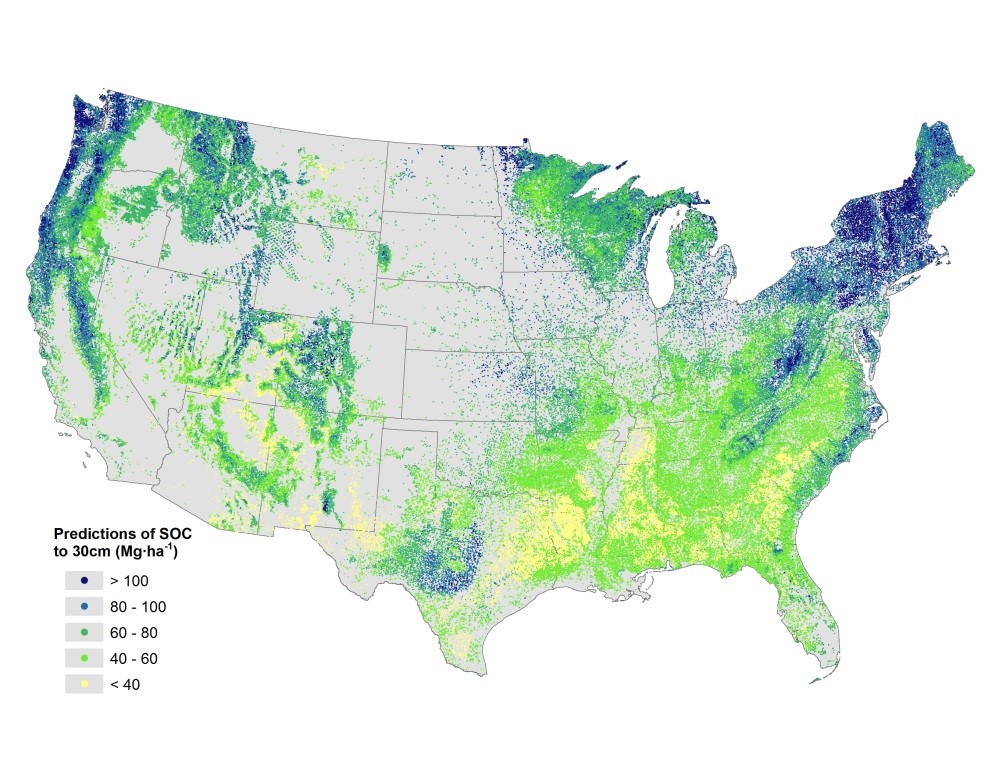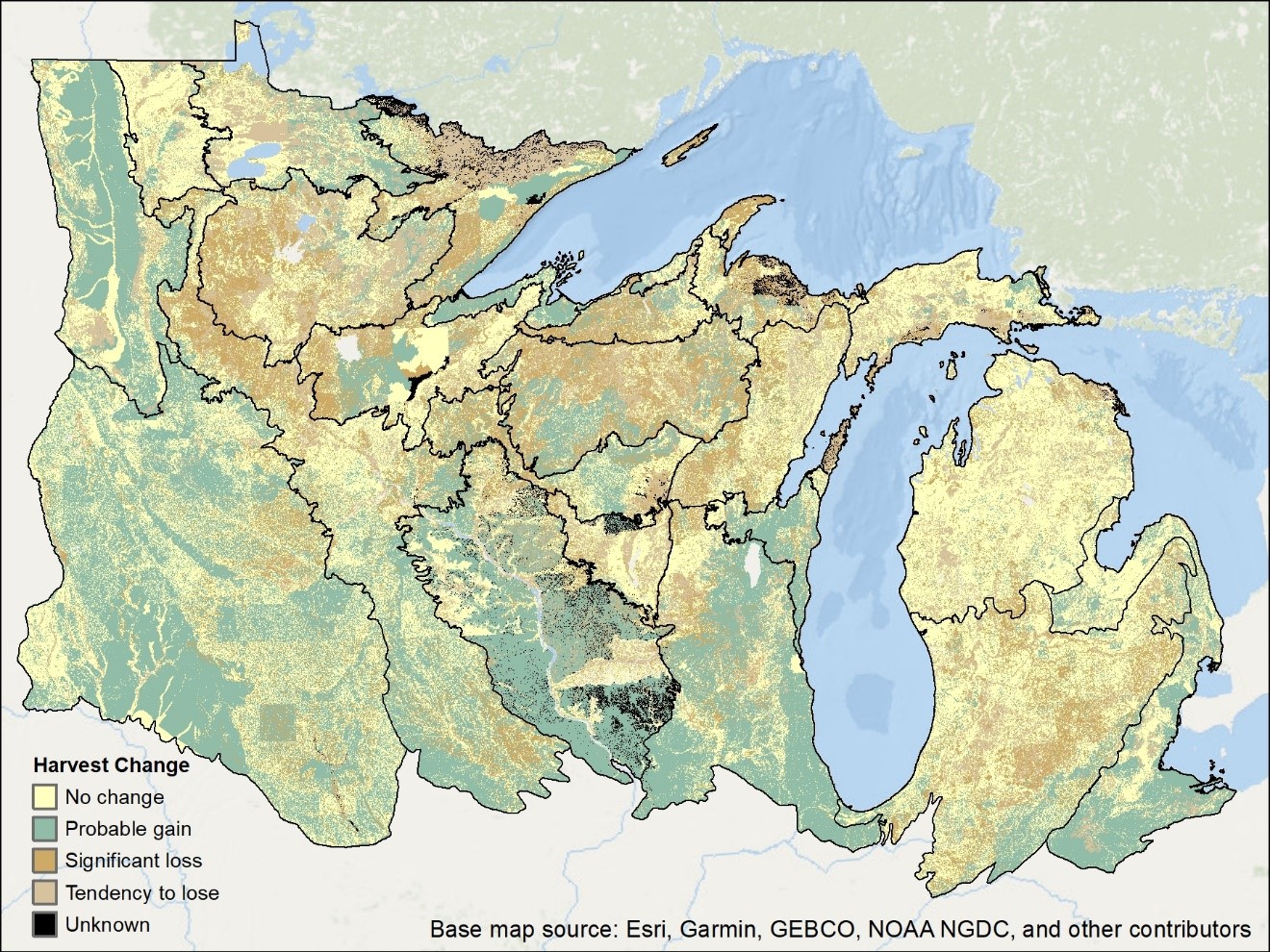Soil carbon plays an important role in northern forests in the Lake States and beyond. New research and USDA resources can help practitioners evaluate potential soil gains or losses based upon management actions.
Soil is composed of many things, and carbon is the glue that holds them all together
Soil organic matter is in many ways the foundation of an ecosystem. Soil organic matter slows down the movement of water through soils, which decreases runoff and erosion, retains and releases moisture needed for plant growth, and filters out pollutants and excess nutrients. Soil organic matter does more than hold on to nutrients, though- it releases them as it decomposes and is, therefore, the main source of nutrients needed by plants. The organic matter even assists with the development of healthy soil structure, whether through its accumulation on the surface as litter or duff layers in forests, or downwards into the profile, as aggregates that bind together mineral particles and organic matter. Soil organic matter, which is by weight mostly carbon, thus plays a critical role in how ecosystems work in their own right and in their capacity to provide a variety of ecosystem services (Nave et al. 2019).

A large percentage of forest soil carbon is found in the Northwoods Lake States region
In the forests of the Northwoods, in particular the Lake States, soil carbon plays an important role. Despite occupying just 6% of the U.S. land area, the Lake States region is estimated to store closer to 10% of the total U.S. forest soil carbon (Nave et al. 2021). This abundance of carbon in the Lake State’s region may be attributed to the cool, humid climate that can slow down decomposition, and due to the young, glacially deposited sediments that readily accumulate soil organic matter. The Lake States also have an extensive cover of forests and wetlands, which produce large amounts of living organic matter—such as leaves, roots, and wood—that eventually dies, moves into, and becomes soil carbon.

Figure. Map of soil carbon stocks- the mass of carbon per area of soil- in the top 12” of soils on forest lands. See Domke et al. (2017) for more information about the map, which was made by combining soils and other information from the Forest Service, NRCS, and the International Soil Carbon Network.
Are there natural soil carbon patterns on the landscape? USDA resources can help to tell the soil carbon story.
Across the familiar landscapes of the Lake States, soil carbon stocks can easily vary by orders of magnitude over very short distances. To visualize how this is the case, picture an undulating field, plowed and ready for planting, you may see black organic-rich soils in the low wet spots where decomposition is slow; and brown or gray soils on the gentle rises, where drier conditions and faster decomposition have allowed less soil carbon to accumulate over the past few millennia.
In most soils, the majority of the carbon present has been there for hundreds to thousands of years. In forests, stark transitions can be observed from the dry sandy uplands that may quickly transition to low-lying swamps where soil carbon readily accumulates, due in part to the differences in the sediments and topography left behind by glaciers that affect soil carbon today. Relationships like these, between soil carbon and geologic history, can be readily observed using USDA data sources like the National Forest Inventory or USDA NRCS Soil Lab. Paired alongside the long history of soil science, ecology, and forestry research in the Lake States, these data sources allow researchers to identify natural patterns in soil carbon stocks. These data sources also set the stage for understanding how soil carbon is altered by climate or land-use change, forest management, and natural disturbances such as wildland fire.
USFS National Forest Inventory database
Collaborative research is helping to refine our understanding of soil carbon and how it is changing
A project led by scientists from the Northern Forests Climate Hub, Northern Institute of Applied Climate Science, the USDA Forest Service, and American Forests recently synthesized data from over 60 years of published papers, >350 National Forest Inventory plots, and >1,700 Soil Survey pedons to address these very issues. The project reported how soil carbon in the Lake States differs across geologic parent materials, landforms, and soil textures (Nave et al. 2021). It also revealed that different parts of Lake States landscapes show opposing soil carbon responses based upon forestry activities, whereas some soils were observed to be gaining while others were observed to be losing soil carbon, an occurrence possibly linked to their geologic parent material and soil texture.
The project also highlighted how soil carbon is rebuilt and accumulated with reforestation activities, particularly on formerly mined lands in the mineral-rich Lake States; and describes how fragile soils maybe recovering carbon in many of the region’s forest plantations, which date back to the restoration activities undertaken at the beginning of the soil conservation movement and the Civilian Conservation Corps.
A tool to visualize soil carbon impacts in real-world scenarios
The Lake States soil carbon team also supports carbon-informed management alternatives and developed a list of resources that can support putting these scientific findings to work in real-world forestry scenarios. The team compiled an evidence-based set of forest-management tactics that can be integrated into planning in an effort to minimize soil carbon losses or to enhance the probability that soil carbon will increase over time. Example tactics are provided under broad categories of forestry, fire, reforestation, and forest restoration, and each one relates directly to broader strategies and approaches of climate adaptation and carbon mitigation (Ontl et al. 2020).
The Lake States soil carbon team also produced a GIS tool for users to visualize how forestry activities affect soil carbon in specific places . This tool, the Harvest Impacts Map, integrates characteristics such as soil texture and parent material—to describe the probability and direction of change in soil carbon stocks (increasing, or decreasing) when forest harvesting operations are conducted.
This GIS tool also includes underlying tabular data to allow skilled users to independently assess or validate the map’s base inputs against other sources of information. This can be helpful information for those seeking to perform environmental assessments or design monitoring programs to assess change.

Lake States soil carbon GIS tool
Resources cited on this page
Domke G.M., Perry C.H., Walters B.F., Nave L.E., Woodall C.W., Swanston C.W. 2017. Toward inventory-based estimates of soil organic carbon in forests of the United States. Ecological Applications 27: 1223-1235. Access this article at the US Forest Service website
Nave L.E., DeLyser K., Domke G.M., Janowiak M.K., Ontl T.A., Sprague E., Walters B.F., Swanston C.W. 2021. Land use and management effects on soil carbon in the Lake States, with emphasis on forestry, fire, and reforestation. Ecological Applications. DOI: 10.1002/eap.2356. Access this article at the US Forest Service website
Nave L.E., Marín-Spiotta E., Ontl T.A., Peters M.P., Swanston C.W. 2019. Soil Carbon Management. Chapter 11 in: Global Change and Forest Soils: Cultivating Stewardship of a Finite Natural Resource. Busse M., Giardina C., Morris D., Page-Dumroese D., eds. Volume 36 in the Developments in Soil Science Series, 544pp. Elsevier Science Publishing, Amsterdam. ISBN: 9780444639981 Access this article at the US Forest Service website
Ontl T.A., Janowiak M.K., Swanston C.W., Daley J., Handler S. Cornett M., Hagenbuch S., Handrick C., McCarthy L., Patch N. 2020. Forest management for carbon sequestration and climate adaptation. Journal of Forestry 118:86-101. Access this article at the US Forest Service website
Angel J.R., Swanston C.W., Boustead K., Conlon K., Hall J., Jorns J.L., Kunkel K.E., Lemos M.C., Lofgren B.M., Ontl T., Posey J., Stone K., Takle E., Todey D. 2018. Chapter 21: Midwest. In: Reidmiller D.R., Avery C.W., Easterling D., Kunkel K.E., Lewis K.L.M., Maycock T.K., Stewart B.C., editors. Impacts, Risks, and Adaptation in the United States: Fourth National Climate Assessment. US Global Change Research Program, Washington, D.C. Access this article at the US Forest Service website

